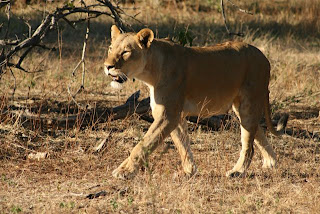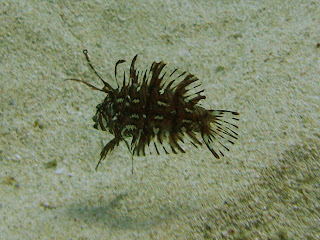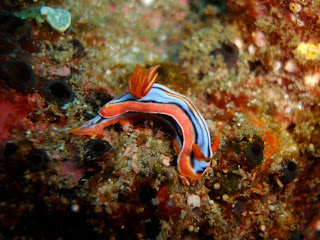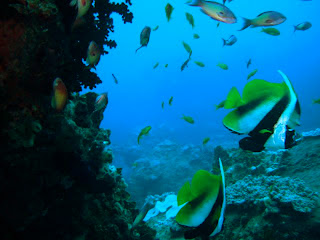 The photograph above shows the Victoria Falls bridge between Zimbabwe and Zambia, which spans the Zambezi river deep in the gorge below (the photo is a 180° panoramic); I jumped off this bridge, but more of that later. The Zambezi itself starts life in northern Zambia, cascades over the 108m high falls, and continues on its way to the Indian ocean; at this time of year, the end of the wet season, some 10,000 tons of water plummets over the edge every second.
The photograph above shows the Victoria Falls bridge between Zimbabwe and Zambia, which spans the Zambezi river deep in the gorge below (the photo is a 180° panoramic); I jumped off this bridge, but more of that later. The Zambezi itself starts life in northern Zambia, cascades over the 108m high falls, and continues on its way to the Indian ocean; at this time of year, the end of the wet season, some 10,000 tons of water plummets over the edge every second.
Entry into Zimbabwe was relatively straight forward - $55 for a visa, $20 more expensive that for every other nationality except for Canadians (they pay $75 – perhaps they've been even more critical of Mugabe than the British government). We had two nights stay in Vic Falls town, so decided to ditch the tent in favour of a room.

The next order of business was to settle down to watch the 2nd test. Having spent the early morning watching buffalo successfully defend themselves against repeated lion attacks, it was a big disappointment to see springbok do the same thing.

Early the next morning Kirsten went off for a horse ride along the Zambezi above the falls, which allows you to get close to the game (wild animals tend to react to a horse and rider the same as to just a horse). This did not prevent Yola's horse getting skittish and throwing her off – a bruised hand and side, and a broken camera.

Jacques, Luke and myself thought the Vic Falls bungee sounded like a great idea, so off we went with our group of supporters . Luke went first, and as it was his first jump, went for the classic swan dive with the rope attached to the ankles. Next up was me, who went for a reverse elevator; this is a trick set-up, with the cord attached to the middle of your torso. With the rope dangling between your leg, you do a backwards star jump, and watch the bridge rush away from you. This was all very well until the guy explained not to lean forwards because the rope will smack you in the face, nor lean back because the rope will go between your leg – neither of which is pleasant. I really wasn't worried up until that point. Anyway dangling 50m below the bridge, waiting for the winch-man to rescue you, you do get a great view of the falls. Jacques did the run and jump method, with a very nice take off.

Among the many things Zimbabwe in notorious for is hyper-inflation; every few years the central bank lops off around a dozen zeros from the Zim-dollar, bringing it back (for a day or so) on approximate par with the US$ - the largest note printed from the 3rd generation series was 100 trillion ($100,000,000,000,000), before the government removed all those pesky zeros and issued the (current) fourth generation notes.
 None of the 3rd generation notes is worth more than the paper they are printed on, but that doesn't stop the locals trying to get $10 for the larger notes (I paid $1 for a 10 trillion note). The local ATMs do issue 4th generation notes, but you'd be stupid to touch it – nobody else does.
None of the 3rd generation notes is worth more than the paper they are printed on, but that doesn't stop the locals trying to get $10 for the larger notes (I paid $1 for a 10 trillion note). The local ATMs do issue 4th generation notes, but you'd be stupid to touch it – nobody else does. The falls are wet. At this time of year so much water thunders over that the spry can completely obscure the view – a small change in the wind can make the difference between having a fantastic vista, and having an unexpected power shower. Of course, when we visited the Zimbabwean side, we took nothing as sensible as a rain coast – so as we emerged, soaked to the skin, a group of South African tourist (in ponchos) found it so funny, they had their photos taken with us.
The falls are wet. At this time of year so much water thunders over that the spry can completely obscure the view – a small change in the wind can make the difference between having a fantastic vista, and having an unexpected power shower. Of course, when we visited the Zimbabwean side, we took nothing as sensible as a rain coast – so as we emerged, soaked to the skin, a group of South African tourist (in ponchos) found it so funny, they had their photos taken with us.
Below the falls, the Zambezi snakes through a deep gorge. During low water, you can raft rapid 1 (a little after the bridge) through to 23, and although the rapids have a lower grade when the water is high, because you can't walk around an impassable grade 6, in high water you must start at rapid 11. Before you start, you must walk down the steep track to the river – easy enough, except we were in flip-flops.
 The huge volume of water in the tight gorge creates large whirlpools and standing waves; going though the rapids can feel more like surfing than rafting. The whirlpools can take you down and hold you for 15 seconds – not long enough to run low on air, but certainly long enough to be quite unnerving. Another danger, is the crocodiles; they wouldn't swim up into the fast moving waters of the gorge, but juveniles washed over the falls can survive – we spotted three on our way down river. Fortunately no one went overboard, but we did get hit by some monstrous waves. Of course, if you raft in a gorge, you have to do the tedious 20 minute slog back out again; fortunately someone else had the task of carrying the raft out.
The huge volume of water in the tight gorge creates large whirlpools and standing waves; going though the rapids can feel more like surfing than rafting. The whirlpools can take you down and hold you for 15 seconds – not long enough to run low on air, but certainly long enough to be quite unnerving. Another danger, is the crocodiles; they wouldn't swim up into the fast moving waters of the gorge, but juveniles washed over the falls can survive – we spotted three on our way down river. Fortunately no one went overboard, but we did get hit by some monstrous waves. Of course, if you raft in a gorge, you have to do the tedious 20 minute slog back out again; fortunately someone else had the task of carrying the raft out.













































